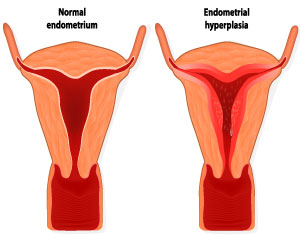The Use of Progesterone Therapy for Hyperplasia
Doctors may prescribe progesterone therapy for hyperplasia in women who are beyond menopause and taking estrogen hormone replacement to reduce the risk of possibly developing endometrial hyperplasia. While progestin is a viable option for some people, choosing the natural bioidentical progesterone may be the better decision.
Progestin therapy for hyperplasia is often recommended for younger women who have irregular menstrual periods. This is typically in the form of a combination birth control pill that contains both estrogen and progestin.
There are four types of endometrial hyperplasia, as shown below with their risk factors for endometrial cancer:
- Simple hyperplasia – 1% risk
- Complex hyperplasia – 3% risk
- Simple atypical hyperplasia – 8% risk
- Complex atypical hyperplasia – 29% risk of progression
Cellular changes that are abnormal signal the designation of atypical hyperplasia. Women who are diagnosed with complex atypical hyperplasia are at a higher risk of cancer, so hysterectomy is often the best choice of treatment once the childbearing years have ended, or if no more children are desired.
Endometrial Hyperplasia Symptoms
The first warning sign that hyperplasia is present is abnormal uterine bleeding.
Women who have any of the following symptoms should contact a doctor to discuss the situation:
- Menstrual cycles averaging less than 21 days from onset of one period to the next
- Heavier bleeding that normal, or a period that lasts longer than it usually does
- Bleeding after menopause
Endometrial hyperplasia is a medical condition that occurs when the uterine lining – the endometrium – becomes too thick. Although it is not cancer, some forms, such as complex atypical hyperplasia can lead to an increased risk of uterine cancer. Doctors sometimes recommend progesterone treatment for uterine hyperplasia to lower these risk factors.
Women with higher levels of estrogen in their bodies and lower levels of progesterone are at an increased danger of developing endometrial hyperplasia for the following reasons:
- In the first part of the monthly cycle, a female’s ovaries produce estrogen which then causes the endometrial lining to grow and thicken in preparation for pregnancy
- An egg is released from one of the ovaries in the middle of the cycle – this is known as ovulation
- After ovulating, the production of progesterone increases to prepare the endometrium for the fertilized egg
- If there is no pregnancy, both estrogen and progesterone levels decline
- Decreased progesterone is the trigger stimulus for the shedding of the endometrial lining – menstruation
- If ovulation does not occur, progesterone production will not increase, and the lining will not be shed, causing it to grow and thicken over time
Progestin Therapy for Hyperplasia – With or Without Contraception
The use of progestin therapy for hyperplasia often occurs after menopause. This is when a woman is at a greater risk of developing endometrial hyperplasia due to the end of ovulation and lack of progesterone production. When used with contraception, such as birth control pills, progestin helps to stimulate the shedding of the lining of the endometrium.
There are certain risk factors that can contribute to the need for progestin therapy for simple hyperplasia, including:
- Being over 35 years of age
- Starting menstruation at an early age
- Being older at the onset of menopause
- Caucasian
- No previous pregnancies
- Smoking
- Obesity
- Family history of colon, ovarian, or uterine cancer
- Diabetes mellitus
- Gallbladder disease
- Polycystic ovarian syndrome
- Thyroid disease
The doctor may prescribe progestin or progesterone treatment for hyperplasia depending on the situation. Progestin is available as a shot, oral medication, vaginal cream, or intrauterine device. Progesterone is also available in many of the same ways.
Effectiveness of Progesterone Therapy for Hyperplasia
For women with simple hyperplasia, the doctor will most likely prescribe high-dose progesterone treatment. For complex hyperplasia, there is a greater risk of relapse after regression, making long-term follow-up essential. This treatment with oral, injectable, or IUD progesterone is prescribed in cases with atypia.
The use of high-dose progestin therapy for complex hyperplasia with atypia should only be offered to women who cannot undergo the surgery for medical reasons, or who have not yet completed childbearing. High dose progesterone side effects could stimulate appetite and weight gain, and although progesterone therapy is often associated with a decline in fat accumulation, it is essential to remember that we are speaking of very high doses of treatment here.
In some cases, an increase in dosage is required after three months if the hyperplasia is still present. Nine months of treatment without progress is often considered to be a failure for response and hysterectomy may need to be discussed at this time. Women who still want to have children should try to proceed as soon as possible otherwise progesterone maintenance therapy followed by endometrial biopsy every six to twelve months should be performed.
Please contact National HRT with any questions about this or any other type of hormone replacement therapy for women and men. Confidential consultations are provided free of charge.
- Wikipedia
- EVERYDAY HEALTH
- Dr.AXE
- Therapeutic options for management of endometrial hyperplasia Vishal Chandra,Jong Joo Kim Doris Mangiaracina Benbrook, Anila Dwivedi, and Rajani Raicorresponding Published online 2015 Dec 1.
- Progestin Therapy of Complex Endometrial Hyperplasia With and Without Atypia Obstet Gynecol. 2009 Mar; 113(3): 655–662
- Controversies in the Management of Endometrial Cancer V. Masciullo,1 G. Amadio,1 D. Lo Russo, I. Raimondo, A. Giordano, and G. Scambia Volume 2010, Article ID 638165, 7 pages Endometrial progesterone resistance and PCOS Received: 8 October 2013 Published: 9 January 2014




